
- SAP Solman Tutorial
- SAP Solman - Home
- SAP Solman - Overview
- SAP Solman - Features
- SAP Solman - Work Center
- SAP Solman - Work Center Structure
- SAP Solman - Implementation
- SAP Solman - Infrastructure
- SAP Solman - Operations
- System Landscape Information
- Guided Procedure Authoring
- SAP Solman - Template Mngmt
- SAP Solman - Test Management
- SAP Solman - IT Task Management
- Change Control Management
- SAP Solman - Incident Management
- SAP Solman - Service Desk
- Business Process Operations
- Application Operations
- Maintenance Management
- SAP Solman - Upgrade Project
- SAP Solman - Root Cause Analysis
- SAP Solman - Reporting
- Consultant Responsibilities
- SAP Solman Useful Resources
- SAP Solman - Questions Answers
- SAP Solman - Quick Guide
- SAP Solman - Useful Resources
- SAP Solman - Discussion
SAP Solman - Quick Guide
SAP Solman - Overview
SAP Solution Manager is a platform to manage life cycle of your SAP solution in a distributed environment.
The key features of SAP Solman are −
It provides tools, methods, and process management content that can be used during preparation of business blueprint, configuration, and implementation.
Using SAP Solman you can ensure that SAP solution environment is operating at its maximum potential with minimum cost.
SAP Solman provides integration tools for SAP BASIS Administrators to manage underlying infrastructure and application and business processes.
It reduces the amount of effort required to manage the centralized SAP and nonSAP systems.
In a distributed environment, SAP Solution Manager is managing system and SAP applications like- ECC, BI, and Customer Relationship module CRM and also covers the non-SAP system in solution life cycle.
Current version of SAP Solution Manager and Release date
Latest version of SAP Solution Manager is SAP Solman 7.2. This version was made available since H1/2016.
Previous SAP Solution Manager 7.1 support Package Stack 14 was released in October 2015, included various new features to run SAP Solution.
The following table shows the SAP Solution Manager Release details −
| Product Name | SAP Solution Manager |
|---|---|
| Version | 7.1 Support Pack Stack 14 |
| Released Date | October 2015 |
| Underlying based product | SAP NetWeaver 7.0 EHP2 |
| Product Name | SAP Solution Manager |
|---|---|
| Version | 7.2 Support Pack Stack 3 |
| Released Date | H1/2016 |
| Underlying based product | SAP NetWeaver |
Key Features
Key features supported in SAP Solution Manager 7.2 are −
- New User Interfaces
- New Release management
- ITSM and Change Request Management
- Adapt SAP HANA in your landscape
- New Process Management
- Enhanced Cloud Support
In the following screenshot, you can see the homepage of SAP Solution Manager 7.2 with new Fiori-based Launchpad as per defined user roles.
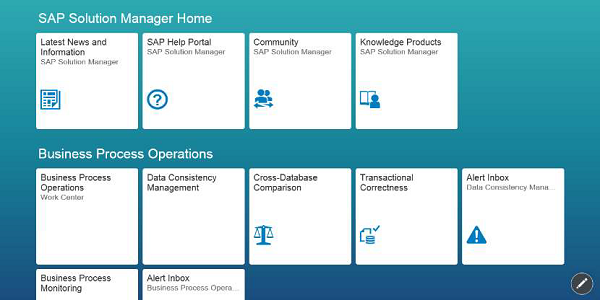
This Fiori-based Launchpad offers role based access to all relevant applications and Work Centers
Supported Browser
Microsoft Internet Explorer
IE11 Desktop (recommended)
IE7-IE10 until Jan 2016
Mozilla Firefox
Latest Extended Support Release Cycle (SAP recommended)
Latest Rapid Release Cycle (a backup browser is needed)
Google Chrome
Cycle for Windows
Apple Safari
On OS X for 3 years from version release date
SAP Solution Manager Product can be divided into following functional categories −
- SAP Solution Manager Operations
- SAP Engagement and Service Delivery
- Solution Implementation
- Template Management
- Test Management
- Change Control Management
- IT Service Management
- Business processes Operations
- Application Operations
- Upgrade and Maintenance
In the following illustration, you can see the SAP Solution Manager and integration with Lifecycle management, IT Service Management, IT Portfolio and Project Management and Business and Application Operations.
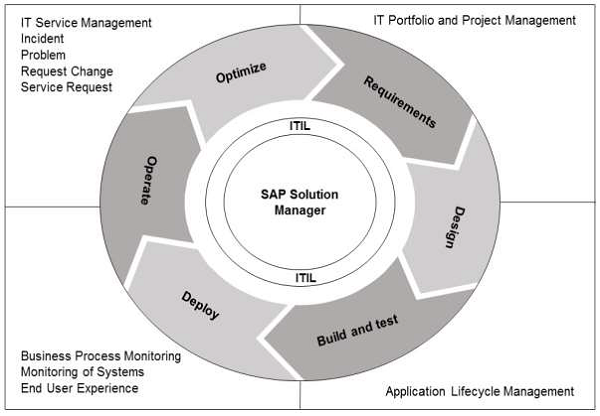
SAP Solman - Features
Following are the key features that are provided by SAP Solution Manager −
Centralized Administration Work Center − Using SAP Solman, you can manage central access of all functions for administrative tasks.
Landscape Management Database − It provides central source of systemlandscape description data.
Issue Management − You can document the problem and issue tracing using issue management feature.
Roadmaps − Using Roadmaps, you can create predefined project plans to cover most important tasks and phases in project implementation as a part of solution implementation.
Template Management − To roll out templates globally, you can use template management.
Test Management − Using Test management, you can perform central test management from test planning to evaluation phase.
Change Control Management − You can use a central change management process, which is integrated with Transport Management. You can transport ABAP and non-ABAP projects using Transport Management Infrastructure.
IT Service Management − This is centrally managed and covers IT infrastructure. You can align IT management processes as per Information Technology Infrastructure Library ITIL. You can set up external Service Desk and access SAP service-support center.
Business Process Operations − Automation of business processes is available in SAP Solution Manager. You can also monitor business critical processes.
Application Operations − You can use Application Operations dashboards to display the availability and performance of your managed systems.
Maintenance Management − You can use Maintenance Planner to create maintenance plans and stack XML files for installation using Software Update Manager (SUM). You can also use system recommendations option to find and display suitable SAP Notes. Maintenance optimizer can be used to start the maintenance process in production system. This provides you detailed instructions for downloading and installing maintenance files in the system.
SAP Solman - Work Center
To perform role specific functions, you can use Work Centers in SAP Solution Manager. Work Centers are work environments that allow you to access role specific options. You can access different options like alerts, notifications, messages, and reports as per the assigned role.
Work Centers provide a set of tools under SAP Solution Manager to manage complete IT Life Cycle. Work Centers perform different technical operations such as System Landscape Management, System Administration, System Monitoring, Project based, and IT Service Management Work Centers.
The available Work Centers in SAP Solution Manager 7.1 are −
- My Home
- Implementation and Upgrade
- Solution Documentation Assistant
- Business Process Operations
- Job Management
- Root Cause Analysis
- Data Volume Management
- SAP Solution Manager Administration
- Change Management
- Test Management
- Incident Management
- SAP Engagement and Service Delivery
- Technical Administration
- System Monitoring
- Technical Monitoring
- Solution Manager Configuration
When you login to SAP Solution Manager Work Center, you can see the following options at the top −
- My Home
- Implementation/Upgrade
- Solution Manager Administration
- Technical Administration
- System Monitoring
To access any of the work center, you should be authorized to access that Work Center, which means that the work center should be assigned to you.
Step 1 − To run Work Center home screen, use T-Code: SOLMAN_WORKCENTER
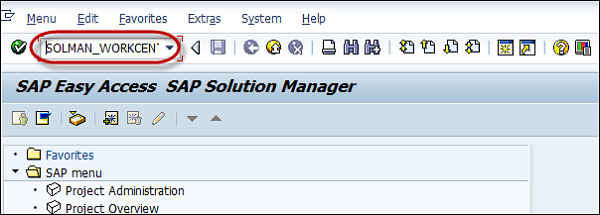
Step 2 − To start all work centers for which you are authorized, you can use the following transaction. For example,
In the SAP GUI for Windows, you can run the Transaction SM_WORKCENTER.

When you call the transaction, the URL for calling up the Web Dynpro application has the following format −
http://< host >:< port >/sap/bc/webdynpro/sap/ags_workcenter?saplanguage=EN
Example
Enter the URL − http://eh5.renterpserver.com:8064
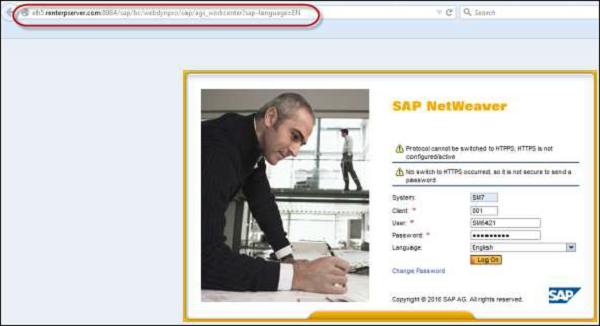
You can also start an individual work center by following Web Dynpro application directly.
To open the Incident Management work center, you can use the URL −
http://
You can see all Work centers that are available under SAP Solman.
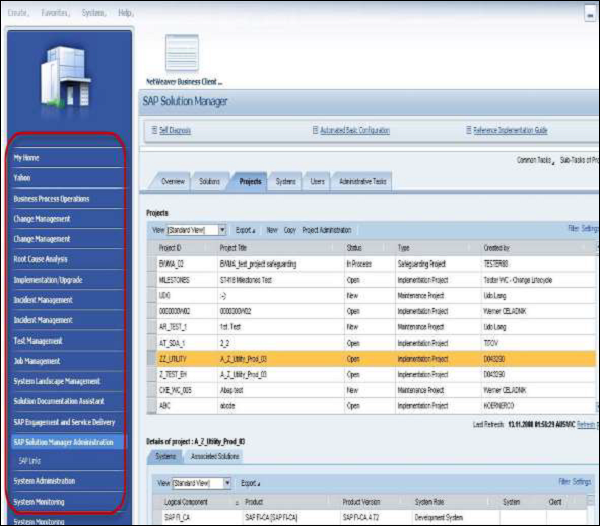
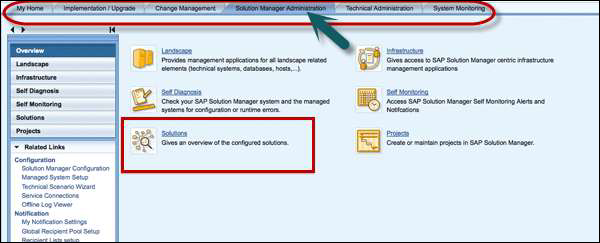
Note − In SAP Solman, there can be one user with one or more roles assigned. In SAP Solman, You can have a role with one or more Work Centers assigned.
Look at the following two screen shots. Here you can see the difference between Work Center using Transaction- SOLMAN_WORKCENTER and Work Center with Web Browser: Service AGS_WORKCENTER.
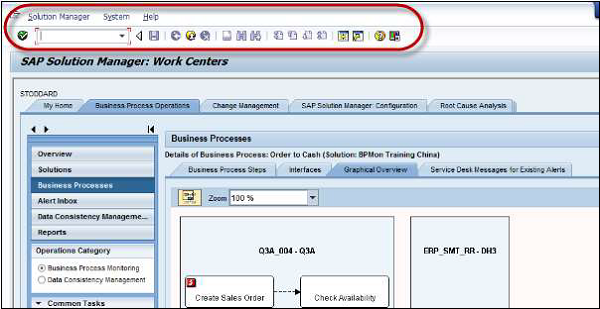
The ribbons of both the Work Centers are different and are highlighted as shown below.
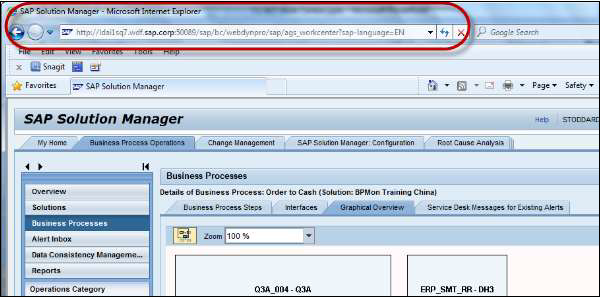
My Home Work Center
In SAP Solution Manager, to access My Home Work Center, you should be authorized for My Home. Using My Home Work Center, you can access all the key data related to other Work Centers in SAP Solman. Using hyperlinks, you can access the work centers that are assigned to you.
My Home Work Center contains the following functions −
Overview − To see the overview of all the work areas under My Home Work Center.
Hyperlink − You can access important links directly under Hyperlink.
Refresh − To Refresh the Work Center and its tab.
Tasks − You can access the assigned Task under Tasks tab.
Reports − To view the available reports, quickly.
SAP Solman - Work Center Structure
All the work centers of SAP Solution Manager have a common user interface. It has same basic navigation features and vary slightly as per the role and use of the work center.
Each Work Center contains the following elements −
Navigation Bar
It shows first level of navigation that you use to choose the Work Center. It provides a role specific navigation bar with access to all the Work Centers associated with the role and assigned to the user who is logged in.
Navigation Area
It shows second level of navigation and you can select different references for a specific work center such as −
- Hyperlinks
- Views
- Functions
Content Area
The content area changes as per the navigation area selected.
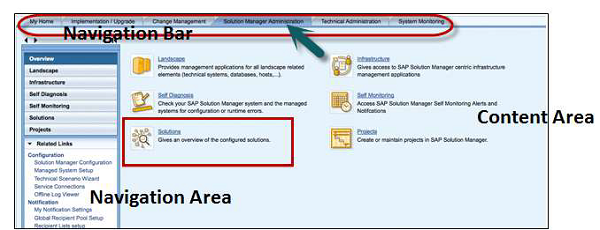
SAP Solman - Implementation
SAP Solution Manager provides you with central access to all the tools, documents, functions, and methods that are required for a project implementation. It supports all the key project phases that you need to configure for business scenarios as a part of solution implementation.
As a part of solution implementation, you need to define the following Project phases −
Defining a Project
First step in solution implementation is to define a project.
Step 1 − Go to Project Administration Work Center. Create a project by defining a system landscape for phases involved in project and scope of the project. As per the scope of the project, structure hierarchy is defined for business processes and scenarios.
In SAP Solman, all the administrative tasks are performed under Project Administration work center.
Run the Transaction Code − SOLAR_PROJECT_ADMIN to open Work Center. Transaction code is a predefined set of functions.

Step 2 − To create new project, go to Project → Create.

Step 3 − Next, enter a project ID and title. The ID must have a combination of letters and numbers up to 10 characters and click continue.

Step 4 − Enter the information under the following tabs while defining a Project. Each tab has multiple fields and a few are optional. The middle column shows the navigation for each tab and the options under it.
| Functions | Navigation/Tab Name | Optional/Required |
|---|---|---|
| Create projects | Project → Create | |
| Specify general project begin and end data | General Data tab | Optional |
| Project language | Required The project language cannot be changed later | |
| Project scope. Copy templates into the project | Scope tab | Optional |
| Assign team members to project | Project Team Members tab | Optiona |
| Definition of project standards (status, documentation types, keywords) | Project Standards tab | Optional |
| Definition of project system landscape | System Landscape tab | Required for subsequent navigation in managed systems |
| Distribution of IMG projects in the managed systems | System Landscape tab IMG Projects subtab | Required for configuration and customizing distribution |
| Create transport requests in the managed systems | ||
| Project transport details | Transport Requests tab | Only in template projects Required for template projects whose templates are to be reused in other system |
| Create, release, transport templates | Templates tab | Only in template projects |
| Download/Upload for Business Blueprint Projects | In a project, choose Edit → Fill Business Blueprint | Optional |
| Manual deletion of persistent locks which the system does not delete automatically | Tools → Delete Persistent Locks | Optional, if you need to unlock objects manually. For more information, see the application help. |
A new screen appears to create a project.
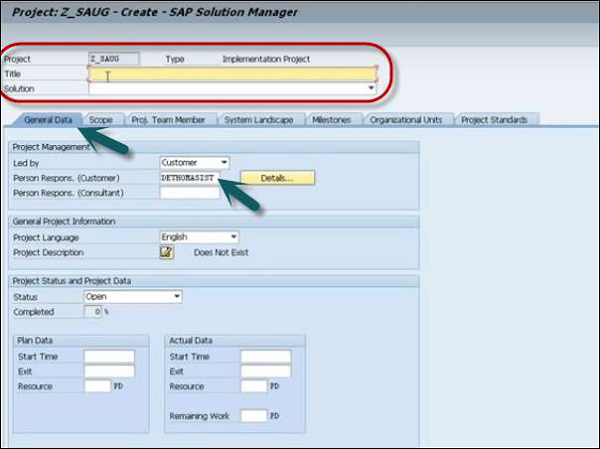
Step 5 − Select the Project type from the drop-down list.

Various project type options are available in SAP Solman.
Implementation project
This is required when you need a project to implement business processes in a SAP landscape.
You can select an existing structure based on business processes or you can also create a new project structure as per the following points −
- One or more user or partner templates
- Based on an existing project
- An existing solution landscape
Template project
Template project is used to create a template that defines the project structure or some part of your project. Templates can also be used in other projects by transporting the template. It is also possible to lock templates against any changes made- either completely or partially when they are used in other projects.
Optimization project
Optimization project type is used to optimize business processes.
Upgrade project
Upgrade project is used to upgrade an existing system. You can upgrade an existing function or add additional functions.
Maintenance Project
Maintenance project type is used to maintain an existing project. This can include Maintenance activities, or correct any existing solution.
Step 6 − Once you select the Project type, enter the following General data −
- Person Responsible
- Project Status
- Led By and other relevant details.
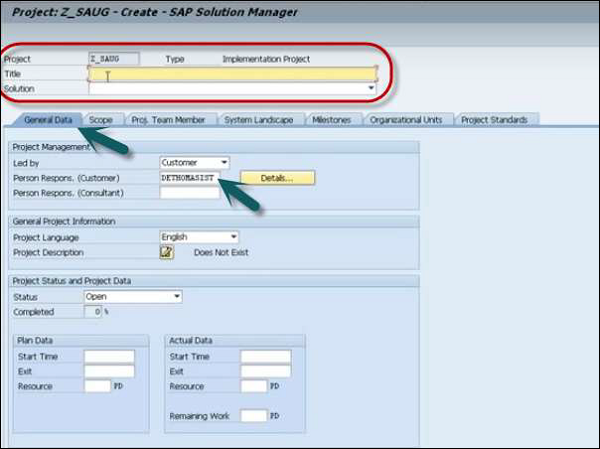
Step 7 − Next define the project scope. Go to the Scope tab and select the Roadmap.
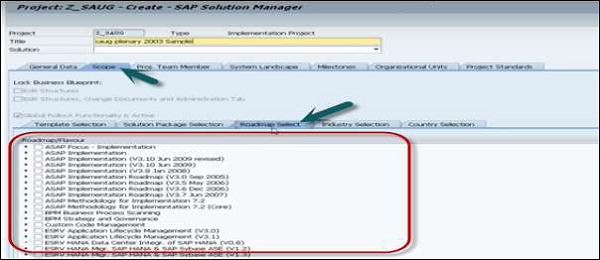
Step 8 − Once you select all relevant options- like Code Management, Business Process Scanning, Focus Implementation, click the save button at the top.
Step 9 − Select Enhancement and Release. Click the green tick mark.

Step 10 − Next is to define project Blue print. Click the Go to button at the top, Project → Business Blueprint.

To define Business blue print, you have to select the source system.
Click the drop-down list. You will see the following options −
Business Process Repository − To define blue Print in business process repository.
Solution − You can define a business blueprint in Solution as package. (Solution in Solution Manager is explained in a separate topic).
Project − You can define the business blueprint as a Project.
Step 11 − Select Business Process Repository from the drop-down list.

Step 12 − Define the Scenario name as per the project scope defined. Go to SAP Solution Manager → Custom Code Management → SAP Solution Manager 7.1
Click the green tick-mark icon.
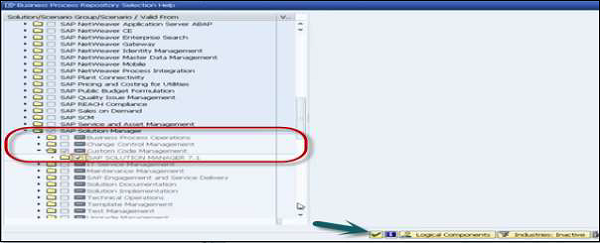
Step 13 − Next step is to assign Logical components.
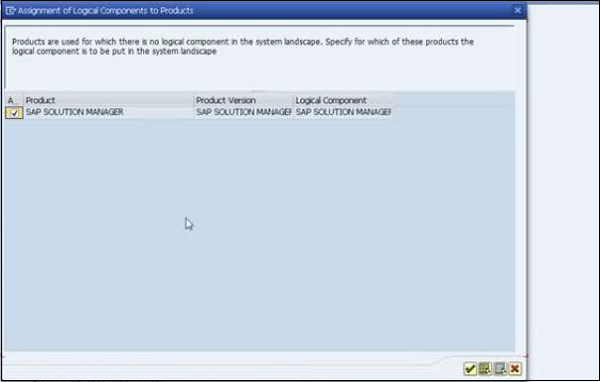
Step 14 − Expand the hierarchy in the left pane as Business scenarios → Custom code management → Business Processes → Custom Code Transparency.
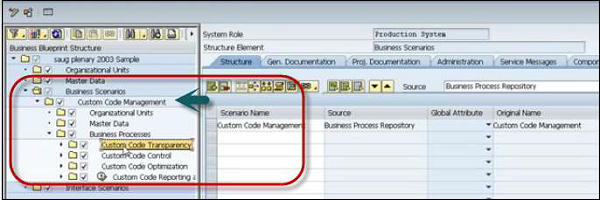
Step 15 − To view the documentation under this project, click the General Documentation tab. You can see all the document types that have been created for this project.

Step 16 − In a similar way, to see full hierarchy and associated document, you can expand any project in the left pane and select any component.
As shown in the following snapshot - Display Results: Reporting/Analysis is selected to see logical component and object name.
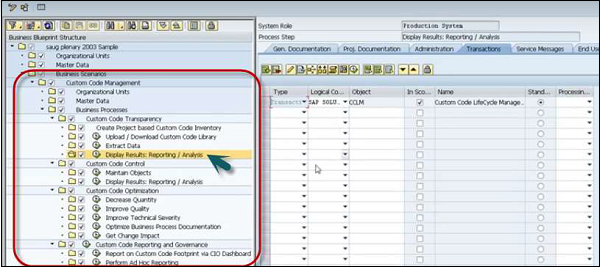
Step 17 − Go to Get Change Impact and you will see logical component and object name for the same.
To see the roadmap, go to Environment → Roadmap

The screenshot given below shows all the phases in Project Roadmap. You can check the details for each object- objective of service, perquisites, deliverables, etc.
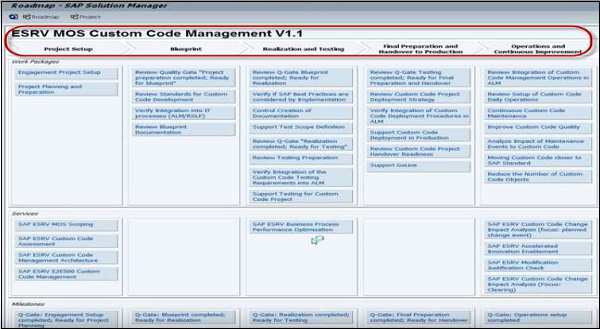
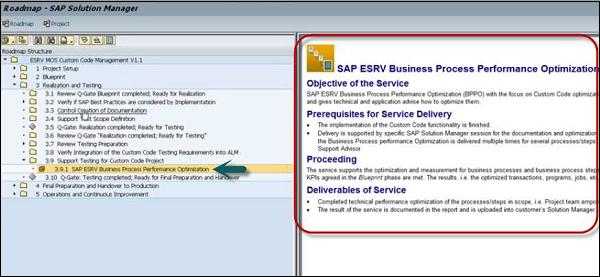
SAP Solman - Infrastructure
SAP Solution manager consists of various infrastructure components- application management solution, and complete IT landscape. The solution discovers- technical monitoring and alerting infrastructure, system landscape information, integration of Solution Manager with SAP IT Infrastructure.
Integration between SAP Solman and IT infrastructure brings more advantages like −
- You can directly access data from SAP Solution Manager regarding IT Service Management processes.
- You can link Incident, Problem, and Change management to infrastructure information.
- It provides enhanced monitoring information inside SAP Solution Manager.
Technical Monitoring and Alerting Infrastructure
The infrastructure allows you to improve the health of your system in complex system landscape. It provides many advantages over common central CCMS monitoring.
You have to configure only central system- SAP Solution Manager and this configuration is distributed automatically to the managed systems.
The following functions can be performed using Technical monitoring and alerting infrastructure −
- You can perform a detailed view of all infrastructure components.
- The diagnostic agents are automatically updated and configured.
- It provides end-to-end monitoring and alerting for all the components in Landscape.
- You can monitor and manage infrastructure alerts in SAP Solution Manager Alert Inbox.
Select Technical Monitoring under Business process Operations.
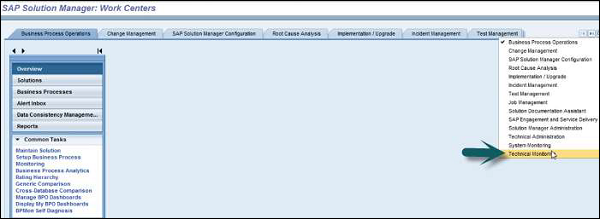
Under Technical monitoring, you can perform various types of monitoring options −
System Monitoring − To perform the monitoring of all the systems in SAP Solman System Landscape.
Connection Monitoring − This is used to monitor connections in your IT Infrastructure.
BI Monitoring − This is for Report monitoring.
PI Monitoring − To monitor Process Integration between different systems. You can select and monitor each component in this landscape by using date from System Landscape Directory.
End-User-Experience monitoring − To monitor the Performance and availability of technical systems from different locations.
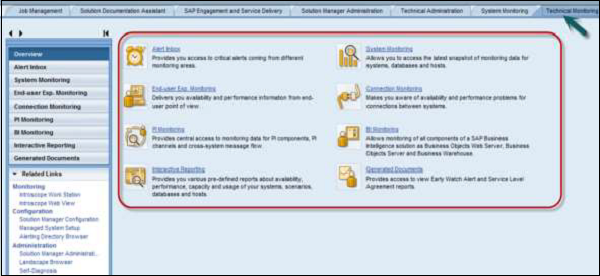
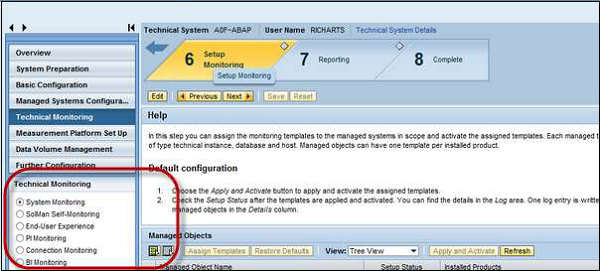
Application Incident Management and Change Management
In SAP Solution Manager, Incident management is closely related to Service desk to manage all your issues related to Applications. When an application fails to deliver the required performance during normal service hours, you need to restore the service to normal operation as quickly as possible. This process is known as Application Incident Management.
Change Management process deals with managing changes in Infrastructure. Change Request can be raised for any routing activity like Patch management, or an urgent change to restore an application/service.
Step 1 − To perform incident management and change management, you can search fields such as Function type, Manufacturer and Name of CI using the search criteria.
Step 2 − From the incident name or change #, you can see the details of Configuration Item
Step 3 − Under Master data, there is a link to search CMDB and LMDB.

Step 4 − To see all the transactions assigned- Incident # and Change # to a Configuration item, you can perform a search in CMDB.
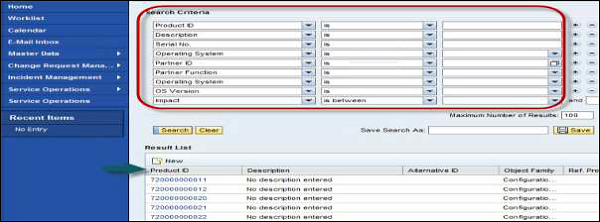
Step 5 − By clicking on any CI, you can view all technical details, object organization data for CI as shown below −
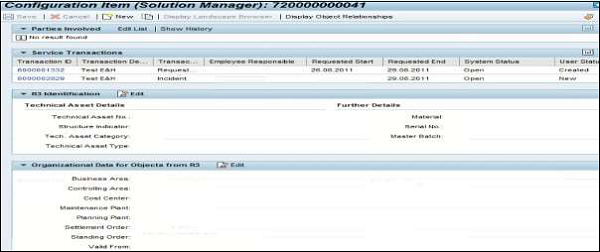
Step 6 − Based on the Configuration item, product ID or object ID, you can create an Incident or Change request in Solution Manager.
CI is available under Object ID in Incident details as shown below −
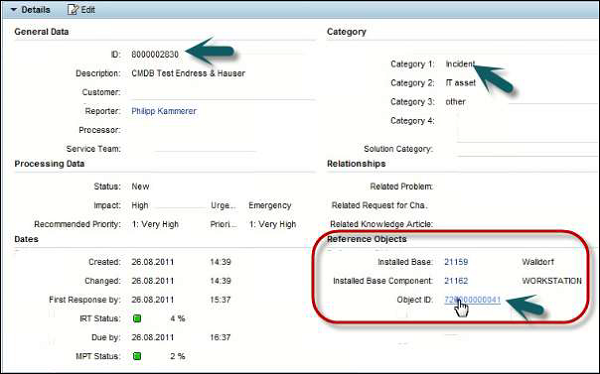
In SAP Solution Management infrastructure, you can use Landscape Management Database (LMDB), which is a central landscape information repository. It uses the same information as the System Landscape Directory (SLD) to enter the system information.
LMDB connection to SLD
LMDB gets all the information from the System Landscape Directory where all the system registers itself. Most of the technical systems contain data suppliers that provides direct information to SLD for registration.
The LMDB receives SLD changes automatically when a change occurs, using polling by LMDB, or active change notifications by the SLD.
Work Modes
You can use various work modes in SAP Solution Manager to perform the following activities −
- Maintenance
- System Migration
- Patch upgrades
- Customizing changes
Work modes can be divided into further two categories −
Technical work mode
Following types of Technical work modes can be used −
Planning Downtime − Technical work mode is defined as the work mode during which the system is technically down and you do not have access. System administrators can use this work mode to perform planned administration tasks that can only be performed during downtime.
Maintenance Mode − Work mode during which the system is technically up and you have no access. System administrators can use this work mode to perform planned administration tasks that can only be performed during maintenance.
Business Work modes
The following types of business work modes can be used −
- Peak Business Hours
- Non-Peak Business Hours
- Non-Business Hours
Note − To use the Work Mode Management reporting functionalities, Monitoring and Reporting has to be enabled for the managed systems.
Roles
The following roles are required to perform Work mode management and IT calendar activities −
- SAP_SM_DTM_DIS Work Mode Management (Display authorization)
- SAP_ITCALENDER Display of Work Modes in IT Calendar
- SAP_NOTIF_DISP Notification Management
- SAP_SMWORK_SYS_ADMIN Work Center: Technical Administration
- SAP_ITCALENDER Display of Work Modes in IT Calendar
Planning a Work Mode
To Plan a Work mode, you have to navigate to Technical Administration Work Center.
Step 1 − Select Work Mode Management → Type Selection area, select a component type.
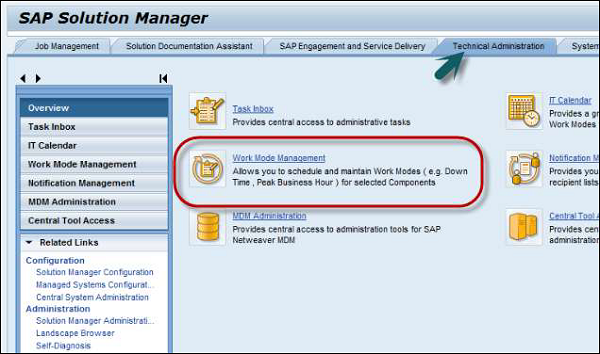
Step 2 − When you select a component type other than EEM Robots, perform the following −
- Go to Detailed Selection area, select a query.
- Group the technical components in queries for faster access.
- In the query, select the technical component → Select Work Mode Management
- Display the work modes, embedded or in a new window.
(An EEM robot is used to perform End user monitoring and is a run time agent. This is used to replay the scripts and one robot per monitoring location is required to perform EEM monitoring),

Step 3 − A hierarchical view of the technical components and details of the current and next work modes are displayed. Next is to select the component. You can see a list of work modes for the component.
Step 4 − If you have selected the component type EEM Robots, select a robot. The list of work modes for the robot is displayed.
Step 5 − Enter Schedule Work Modes. In the Schedule Work Mode for technical component screen area, you can enter the required data.
Note − You can plan only peak business hours, non-peak business hours, or non-business hours for an EEM robot.
Configuring Technical Monitoring as per Work Modes
In SAP Solution Manager, you can setup work modes for Technical Systems, databases and technical scenarios. You can switch off complete technical monitoring or modify single metric thresholds of specific systems.
For each work mode, you can define if monitoring is enabled or not. If you observe that the Planned Downtime check box is deselected, it means alerting and monitoring is disabled
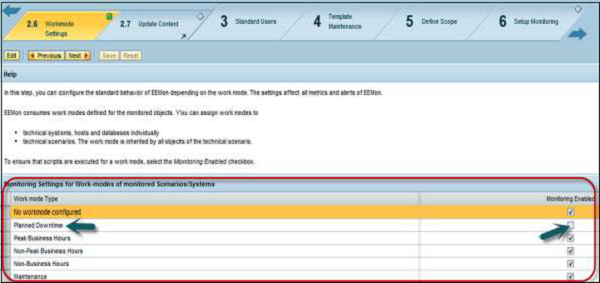
SAP Solman - Operations
In SAP Solution Manager, you have different functions and tools to perform SAP Solution Manager Operation’s activities. These are −
Administration Work Center − Contains all the functions that are required to run SAP Solution Manager.
Landscape Management Database (LMDB) − It is the central landscape information repository and it uses the same System Landscape Directory to enter the system information.
Solutions − Using solution, you can bundle the system and processes as per the requirement to monitor the operation.
Supportability Performance Platform (SPP) − This is used to enhance the performance of a system and to monitor performance management indicators.
Administration Work Center
You can perform various operation activities in Administration Work Center in SAP Solution Manager.
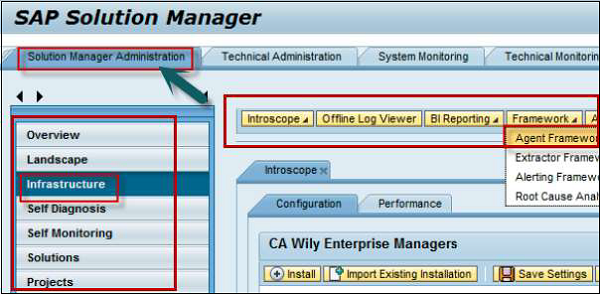
The following operation activities can be performed −
Overview − To quickly see all the Work areas in this Work center.
Landscape − To create RFC connections, manage system modeling and diagnostics agent.
Infrastructure − To create or edit a technical system, and to manage different templates like store and extractor templates.
Self-Monitoring − To monitor large number of alert types, monitoring of applications to identify key problems early on, and alerting infrastructure.
Projects − To display detailed information about projects.
Self-Diagnosis − To monitor SAP solution manager and all other managed systems in Landscape.
Work Mode Management − To perform the following activities −
Maintenance
System Migration
Patch upgrades
Customizing changes
Landscape Management Database
In SAP Solution Management infrastructure, you can use Landscape Management Database (LMDB), which is a central landscape information repository. It uses the same information as the System Landscape Directory to enter the system information.
LMDB gets all the information from the System Landscape Directory where all the system registers itself. Most of the technical systems contains the data suppliers that provides direct information to SLD for registration.
The LMDB receives SLD changes automatically when a change occurs, using polling by LMDB, or active change notifications by the SLD.
Solutions
Using solutions, you bundle the system and processes as per the requirement to monitor the operations. When system and business processes are entered in a Solution, following applications can be used in SAP Solution Manager −
- IT Service Management
- System and Business Process Monitoring
- SAP Engagement
- Reporting
The Solution view in Administration work center contains a list of all the solutions that can be searched using a Solution type or solution ID. You can also import and export solutions between different systems −
Step 1 − Click Goto → Solution Transfer. Each solution can be called by its name or ID.
Under Solution tab, you can perform the following functions −
- Creating a new solution
- You can copy existing solutions as templates to be used to create new solutions
- Activing/Deactivating Solution
- Deleting A Solution
Step 2 − To call a list of service connections for a selected solution for which you can create a system connection to SAP, Click Goto → Service Connection.
Step 3 − To transfer solutions between different systems by exporting and importing them, choose Start of the navigation path Goto → Solution Transfer.
Step 4 − To set which solution data system should send like Production data, click Goto → Solution Settings
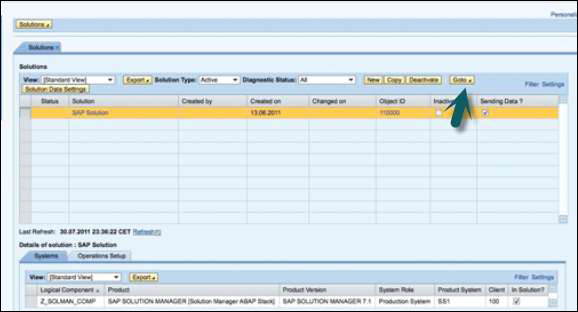
How to create a Solution?
To create a Solution, click Create Solution. Enter the name of solution. You can edit the list of system roles.
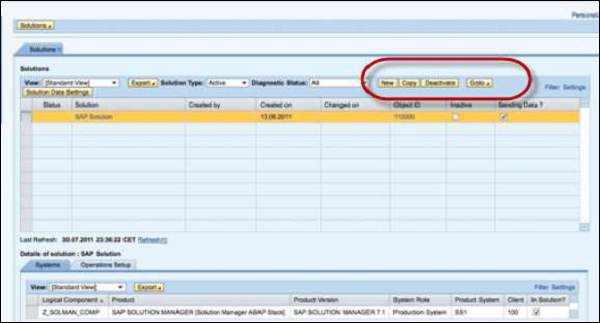
You can also copy an existing solution by clicking the Copy button.
System Landscape Information
We have covered some part of System Landscape information under Solution Manager Infrastructure. SAP Solution Manager applications- Technical monitoring, system maintenance captures all information regarding upgrades with Maintenance planner, alerting policy from system landscape. SAP Solman contains the detailed information about technical system landscape.
LMDB is a central repository for Solution Manager to capture all the information and it uses the same CIM model that is used by System Landscape directory. Landscape information contains two parts- SAP software catalog CR content and information sent from SLD.
LMDB connection to SLD
LMDB gets all the information from the System Landscape Directory where all the systems register itself. Most of the technical systems contain data suppliers that provides direct information to SLD for registration.
The LMDB receives SLD changes automatically when a change occurs, using polling by LMDB, or active change notifications by the SLD.
SLD contains data from managed system and their data suppliers, which automatically pass all the information in SLD. The transaction code used for ABAP system is RZ70.
SLD Synchronization is the most common way to transfer Landscape information to LMDB. When Solution Manager is initially set up, it transfers complete Landscape from SLD to LMDB in Solution Manager. This also includes the information from Software catalog.
Once initial full synchronization is done, an incremental synchronization is triggered every 10 minutes.
System Landscape Directory
This directory contains the information about landscape and software component versions. A SAP system can be configured to register under SLD. System Landscape Directory manages information about all installable and installed elements of your system landscape.
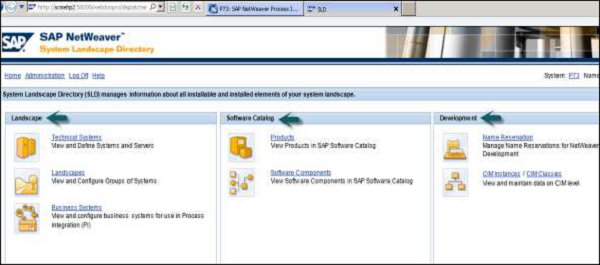
You can find the following links in a web page −
Landscape − Under Landscape, you can find the following options.
Technical Systems − You can view and define systems and servers.
Landscapes − You can view and configure group of systems.
Business Systems − You can view and configure business systems for use in Process Integration.
Software Catalog
Products − To view products in SAP software catalog.
Software components − To view software components in SAP Software catalog.
Development
Name Reservation − This is used for name reservation for NW development.
CIM Instances − This is used to view and maintain data on CIM level.
System Landscape Directory is based on SAP NetWeaver. The following versions of SAP NetWeaver are supported for SLD synchronization with LMDB −
| SAP NetWeaver Release of SLD System | Minimum Support Package Level of SAP NetWeaver |
|---|---|
| SAP NetWeaver 7.0 | not supported |
| SAP NetWeaver 7.0 EHP1 | not supported |
| SAP NetWeaver 7.0 EHP2 | SP 17 |
| SAP NetWeaver 7.1 | SP 19 |
| SAP NetWeaver 7.1 EHP1 | SP 14 |
| SAP NetWeaver 7.2 | not supported |
| SAP NetWeaver 7.3 | SP 12 |
| SAP NetWeaver 7.3 EHP1 | SP 14 |
| SAP NetWeaver 7.4 | SP 9 |
| SAP NetWeaver 7.5 and higher | all SPs are supported |
When your Central System Landscape Directory, integrated with LMDB, does not meet the requirement, you can use a local SLD and synchronize it with central SLD.
Managing Technical System Information
Technical system is known as a software element installed on host system. It can be a standalone system or software elements installed in distributed environment. Technical systems are central element of the Solution landscape in terms of software component deployment and operational activities, such as monitoring and alerting
When a software is installed, technical components are created in the system and they are registered under System Landscape Directory. This information is forwarded to Solution Manager LMDB either manually or using synchronization between LMDB and SLD.
Technical systems are identified using their name, system id or any installation number that has been assigned. Common Technical system types can include −
- Application Server (AS) ABAP
- Application Server Java
- TREX system
In the following table, you can see different Technical system types that can be maintained in LMDB, their source and Editor.
The following technical system types can be maintained in LMDB −
| Technical System Type | Source | Editor |
|---|---|---|
| .NET System | Manual creation | LMDB technical system edito |
| Apache Tomcat Server | SLD data supplier | LMDB technical system editor |
| Application Server ABAP | SLD data supplier | LMDB technical system editor |
| Application Server Java | SLD data supplier | LMDB technical system editor |
| SAP BusinessObjects Cluster | SLD data supplier | LMDB technical system editor |
| SAP Web Dispatcher | SLD data supplier | LMDB Technical System Editor |
| SAP HANA Database | Either SLD data supplier | LMDB technical system editor |
| SAP Mobile Platform | SLD data supplier | LMDB technical system edito |
| TREX System | SLD data supplier | LMDB technical system editor |
| Unspecific 3-Tier System | Manual creation | LMDB technical system editor |
| Unspecific Cluster System | SLD data supplier or manual creation | LMDB technical system editor |
| Unspecific Standalone Application System | SLD data supplier or manual creation | LMDB technical system editor |
SAP Solman - Guided Procedure Authoring
Guided Procedure Authoring provides a set of tools such as Browser and Guided procedure logbook to create guided procedure for activities that are performed periodically. Guided procedures are executed in different scopes i.e. technical system, host, and databases and for different application areas.
Guided procedures in solution Manager can be used to achieve following benefits −
- To perform complex processes.
- Business critical processes can be executed with less risk.
- To speed up the processes.
GPA can be integrated with different application modules −
- Business Process Operations
- Application Operations
- Message flow monitoring
- Database Comparison
- IT Task Management
- Alerting and Monitoring
Launching Guided Procedure Environment
To launch Guided Procedure Environment follow the steps given below −
Using Transaction code: GPA_ADMIN or from a work center, you can open Guided Procedure Browser from the following work centers −
Root Cause Analysis → Exception Management → Guided Procedures or Business Process Operations → Data Consistency Management → Cross Database Comparison.
Different tools under Guided Procedure Authoring includes −
GPA Browser
Using GPA Browser tool, you can create, delete, preview, search or export guided procedures, and update the content of delivered SAP Guided Procedure.
The screenshot given below shows you the home screen of GPA browser.
Using Application area option, you can group GP for a function area.
Search Attributes
You can apply filters to the guided procedures.
When you clear search attributes, GP browser displays all the Guided Procedures as per the functional area.
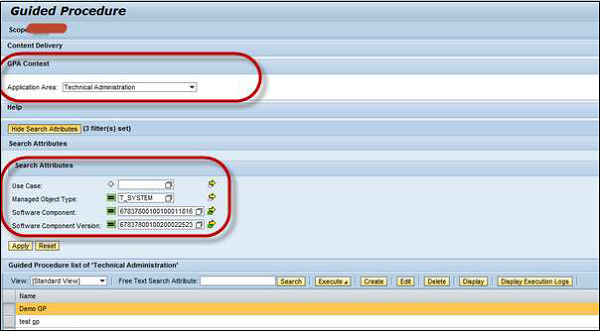
Content Delivery Pane
This option can be used to alert the customers when new content is available and it also proposes to import it.
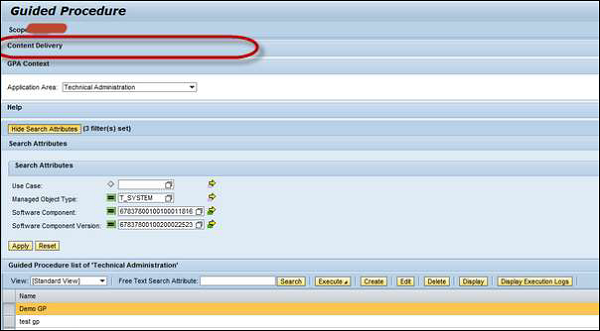
Application Area
You can use the following Application areas in GPA −
- BI Monitoring
- Business Process Monitoring
- Cross Database Comparison
- Advanced Monitoring Configuration
- Data Volume Management
- End User Monitoring
- Exception Management
- Exception Management Configuration
- Interface and Connection Monitoring
- Job monitoring
- PI monitoring
- System Monitoring
- Technical Administration
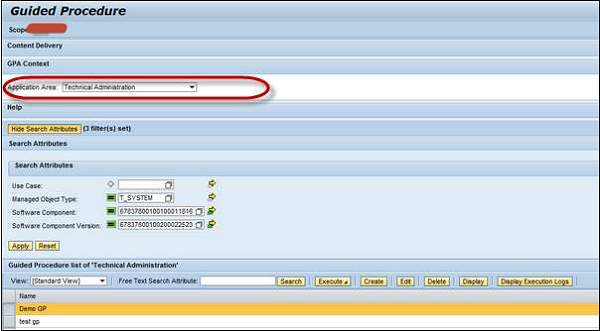
GPA Maintenance
Using the GPA Maintenance tool, you can modify, activate, transport, and review the already existing Guided Procedures. To open Guided Procedure Maintenance, you have to open GP Browser → 3 buttons of GP Maintenance UI. These are −
Create button − To create a new GP.
Edit button − To modify a GP.
Display button − To show the details of a GP.
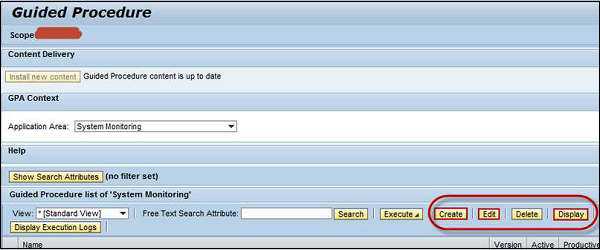
GPA Log Book
This tool of GPA is used to view instances, logs, and to export to HTML, and start new instance. You can access Guided Procedure Log from GP Browser for the selected scope and for the selected guided procedure.
You can use the filtering section to filter the logs. IT is also possible to export the logs to different formats- Excel, HTML, etc.

GPA Content Delivery
This tool is used to raise alerts incase when new content is available. Customer is notified about the new content at two places. First is when GP is opened and the customer executes a guided procedure, he will see a message informing him that new GP content is available.
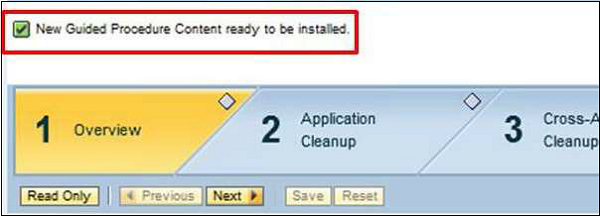 The second option is when the GP Browser is opened, a message is displayed that the Content Delivery area shows the current status of GP content.
The second option is when the GP Browser is opened, a message is displayed that the Content Delivery area shows the current status of GP content.
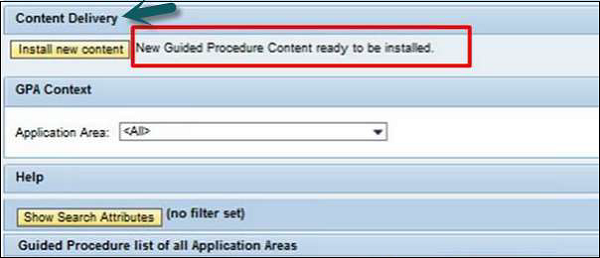
GP Runtime
This tool is used to execute a guided procedure, to check status of execution. When you open a Guided Procedure in GP Browser UI or you can select preview in Guided Procedure Maintenance, it opens the guided procedure runtime UI and you can execute GP.
SAP Solman - Template Management
In SAP Solution Manager, using template management you can create templates at global level – for blueprint documents, business scenarios, and configuration and they can be distributed. The templates can be reused in other projects and solutions.
Creating a Template
In SAP Solution Manager, to create a template, you have to start with a template project.
Step 1 − Go to Project Administration,

Step 2 − Next, enter the Project name and select the Project Type. Project type would be the Template Project to create a Template. Select the Solution where you want to create this Project.

Step 3 − In the next window, you have to enter the following details- Language, Project Title, Person Responsible, and other options under General tab.
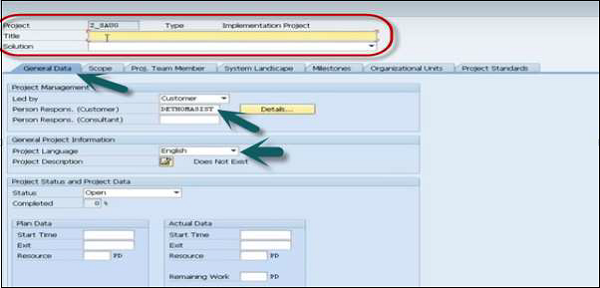
Step 4 − Once you enter all the details, click the save button at the top. You have to select Enhancement version and Release. Click Continue. Select Package → Continue.

Step 5 − Next click the Templates tab at the top. Click the Create Template button. Enter Template and name and click Continue.
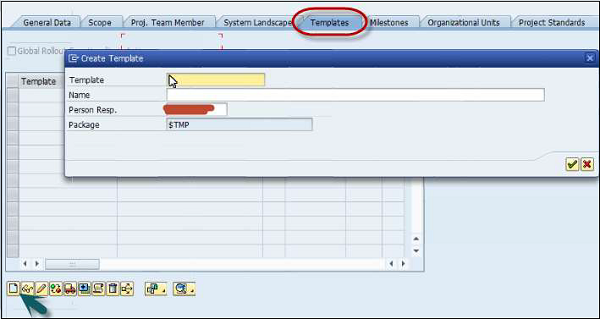
Step 6 − You can create multiple templates in one project. Select Global Rollout Functionality is Active for the templates.

Step 7 − Go to System Landscape tab and select logical component/System to add to projects. You can perform a search for a particular system/logical component.
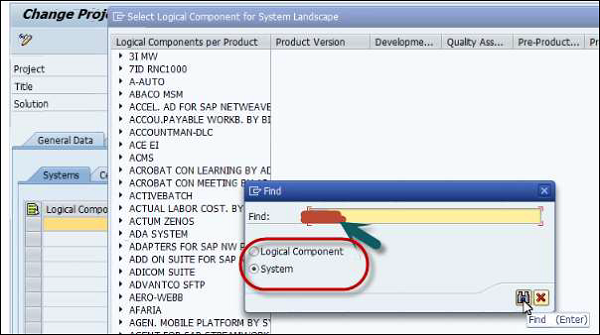
Step 8 − When all the logical components are selected under System Landscape, click the Save button at the top.

Step 9 − Next define Business Blueprint structure, go to Edit → Business Blueprint Fill.
Step 10 − Select the structure file → Open → Continue.

Step 11 − Next is to define Business Blueprint, click on Goto → Project → Business Blueprint

Step 12 − Navigate to Business Scenarios in the left pane. Select Scenario names. Go to Structure → Scenario Name and select Scenario.

Step 13 − Assign templates and set global attributes. Go to Template and select the templates created.
To select Attributes, go to Global Attribute and select Global from the drop-down list. Once you select the templates and global attributes, click the save button at the top.

Releasing Templates for the Projects
To release the templates for projects,
Step 1 − Click Goto → Project Data to come to the main screen. Go to the Template tab and select template. Click Change Visibility to release the templates.
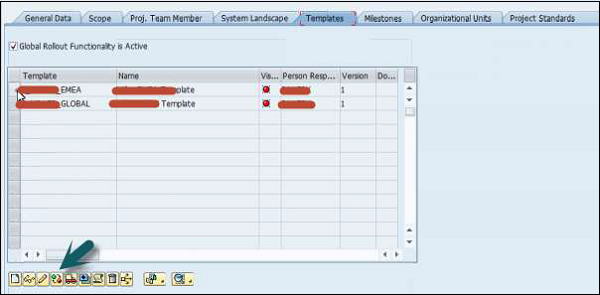

Both the templates will change visibility to Green and they can be used in projects.
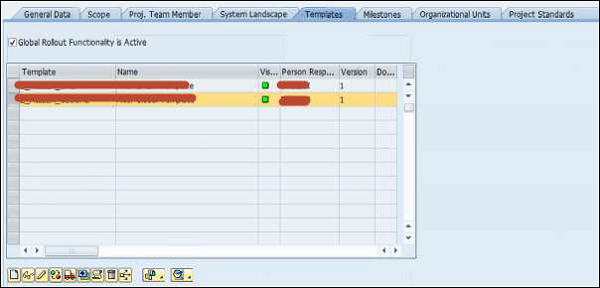
SAP Solman - Test Management
In SAP Solution Manager, you can perform the test-management process central and execute tests for cross system business processes.
Test Management involves the following steps −
- Defining Test Scope
- Test Planning
- Testing
- Transfer changes to production
To perform Test Management activities, you can use Test Management Work Center- to create, manage, and execute test plans.
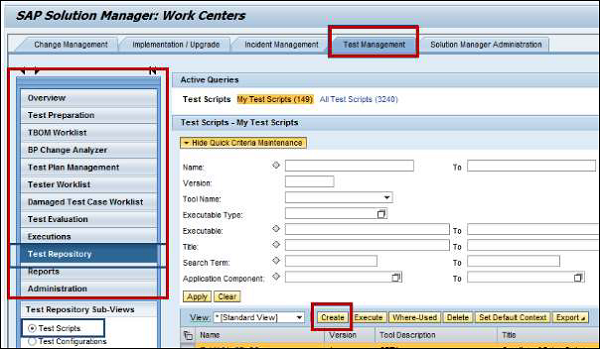
Under Test Preparation, you can create a report that allows you to get an overview of your business processes and status.
TBOM worklist, is used to display your TBOM edit task
BP Change Analyzer, to analyze changes to system. You can use this to ensure how business processes will respond after changes.
Test Plan Management − You can perform the following functions in Test Management Work Center → Test Management Plan −
To create Test Plan − Select Test Plan → Create Test Plan
To copy Test Plan − Select Test Plan → Copy Test Plan
To change Test Plan − Select Test Plan → Edit Test Plan
To change the Attributes of a Test Plan − Click Goto → Attributes
To transport Test Plan − Select Test Plan → Transport Test Plan
To create and Assign Test Packages − Click Goto → Test Package Management
To sort Test Cases in Test Sequences − Click Goto → Sequences
To assign Testers to Test Cases − Click Goto → Sequences
Tester Worklist − This is used to directly access all the test cases assigned to you.
Test Repository − You can use this to create and edit automated test cases.
SAP Solman - IT Task Management
In SAP Solution Manager, you can use IT Task Management to manage objects such as Technical system, databases by Operations team. Tasks can be created using Guided Procedure in standard and expert mode.
Creating Tasks under IT Task Management
You can create new tasks by going to Technical Administration Work Center → IT Task Management. These tasks can be created by scheduling Guided Procedures for managed objects.
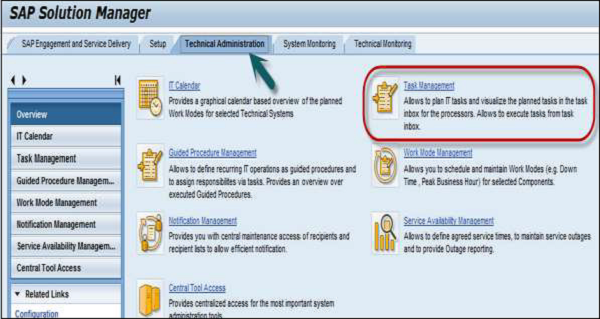
Step 1 − Go to IT Task Planning embedded or in a new window.
Step 2 − In Plan pushbutton, you have to select Guided Procedure- Standard or Guided Procedure- Expert.
Step 3 − For GP Standard, select one or more guided procedures from the available guided procedures list and you need to enter the scheduling information.
Step 4 − Click Assign/Change and choose Managed Objects.
Step 5 − Managed Object dialog box appears. Enter the required managed objects and click Add button → choose OK.
Integration of GP Management and Task Management
Using integration between Guided Procedure (GP) and Task management, allows you to define recurring administrative tasks as GP in GPA environment. It allows you to plan the execution of the defined guided procedures and you can execute Guided procedures centrally.
Using Guided Procedure, it supports daily IT operation tasks by performing the following activities −
- Step-by-step execution
- Detailed activity description
- Central access to required managed system functions
- Automatic steps or activities
- Logging of every activity
GP Authoring Tools
Different tools under Guided Procedure Authoring include −
GPA Browser
Using GPA Browser tool, you can create, delete, preview, search or export guided procedures, and update the content of delivered SAP Guided Procedure.
GPA Maintenance
Using GPA Maintenance tool, you can modify, activate, transport, and review the already existing Guided Procedures. To open Guided Procedure Maintenance, you have to open GP Browser → 3 buttons of GP Maintenance UI. These are −
Create button − To create a new GP.
Edit button − To modify a GP.
Display button − To show the details of a GP.
GPA Log Book
GPA Log Book is used to view instances, logs, and to export to HTML, and start new instance. You can access Guided Procedure Log from GP Browser for the selected scope and for the selected guided procedure.
GPA Content Delivery
The GPA Content Delivery tool is used to raise alerts incase when new content is available. Customer is notified about new content at two places. First is when GP is opened and customer executes a guided procedure, he will see a message informing him that new GP content is available.
GP Runtime
The GP Runtime tool is used to execute a guided procedure, to check status of execution. When you open a Guided Procedure in GP Browser UI or you can select preview in Guided Procedure Maintenance, it opens the guided procedure runtime UI and you can execute GP.
IT Task Management Configuration
In SAP Solution Manager SP12 or higher, you can perform IT Task Manager Configuration using Guided Procedures. Run Transaction Code: SOLMAN_SETUP
SAP provides predefined users and roles to perform IT task management scenarios. The following user types and roles are needed to configure IT Task management −
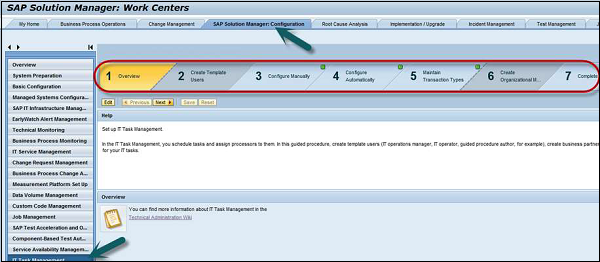
GPA User
A GPA user is required to create custom guided procedures. Using GPA user, you can perform −
- Display Business partner queries
- Access Technical Administration WC
- Task Inbox
- Maintain Guided Procedures
Required Roles under GPA user −
- SAP_SMWORK_BASIC_TECHADMIN
- SAP_SM_BP_DISPLAY
- SAP_SM_GP_ADMIN
- SAP_SYSTEM_REPOSITORY_DIS
IT Task Planning User
IT Task Planning User is required to perform single or periodic operation activities and to check the status of all the activities using GP log book.
Roles under IT Task Planning
The following roles are required under IT Task Planning −
- SAP_SM_GP_DIS
- SAP_TASK_INBOX_DIS
- SAP_TASK_PLANNING_ALL
- SAP_SMWORK_BASIC_TECHADMIN
- SAP_SM_BP_DISPLAY
- SAP_SM_IT_EVENTS_DISP
- SAP_SYSTEM_REPOSITORY_DIS
- SAP_TASK_INBOX_ALL
- SAP_ITCALENDER_DIS
IT Operator User
IT Operators are used to execute the task or Guided Procedures assigned in Task Inbox.
Required roles under IT Operator
The following roles are required under IT Operator −
- SAP_SM_BP_DISPLAY
- SAP_SM_GP_EXE
- SAP_SMWORK_BASIC_TECHADMIN
- SAP_TASK_INBOX_ALL
- SAP_TASK_PLANNING_DIS
- SAP_SYSTEM_REPOSITORY_DIS
SAP Solman - Change Control Management
Change Control Management in SAP Solution Manager is used to manage changes such as implementation and upgradation in all the projects. Change requests are raised for application components and technical components, and implemented as per requirement.
Change Control administration consists of the following key activities −
Change and Transport System − This allows you to distribute changes in ABAP and non-ABAP objects. Use central Change and Transport system to perform the changes.
Quality Gate Management − Quality gates allow to remove the lock on systems and change implementation is possible.
Change Request Management − It allows you to execute projects globally in Solman- includes planning, cost management and change management activities.
Change Management Work Center
This work center allows you to manage all the changes in the project and provides central access to all the tools. To access Work Center, you should be authorized to view this.
To open Change Management Work Center, use Transaction SM_WORKCENTER.
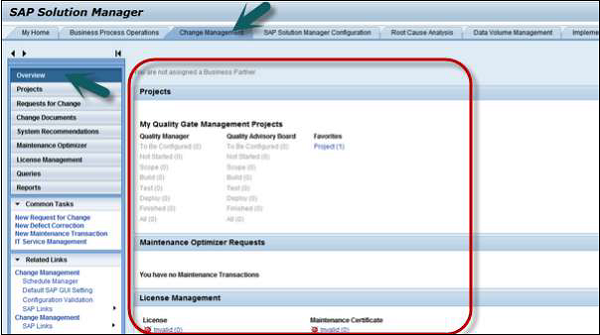
This work center consists of the following functions −
Overview
The Overview tab consists of the summary of all functions in Change Management such as −
You can view Quality gate management projects assigned to your business partner.
All the requests for change assigned to your business partner.
You can also view all the changed documents assigned to your business partner and they can be further filtered based on different parameters.
License management information.
Projects − In this tab, Quality Manager and Quality Advisor boards can view status of software changes phase wise in system landscape.
Request for Change − Using this tab, you can view the list of all change requests and to further drill the details of each request. You can display or edit a change request by clicking on the request.
Change Documents − This tab is used to view all change documents, you can display and edit change documents by clicking on any document and also you can apply filter status wise.
System Recommendations − This tab is used to view system recommendations for an active solution.
Maintenance Optimizer − This tab is used to view the list of all product maintenance transaction and you can edit and display a specific product maintenance transaction.
License Management − This tab is used to manage the licenses centrally and to maintain certificates in system Landscape. You can also download licenses and certificates locally or can also activate/deactivate distribution of certificates on a system.
Queries − To perform complex searches, you can use queries that allows you to search by change documents, change requests, etc.
Reports − This is used for analyzing change management process- change requests and change documents.
Creating a Change Request
To create a change request, role SAP_CM_REQUESTER should be assigned.
You can create a new change request from the start or by using the copy option from an existing template.
Step 1 − To create a request, go to Request for Change − Create.
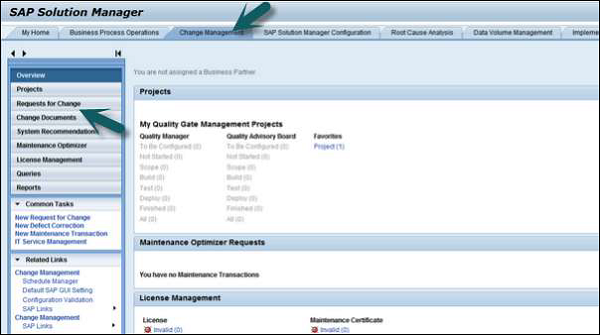
Step 2 − Enter all the mandatory fields, like −
- Description
- Sold to Party
- Requester
- Change Manager/ Approver details
- Approval Procedure
Step 3 − Click the save button to create change request. A change request can be created from the following reference objects −
- From WebUI Client
- From an Existing Template
- From Business Blueprint
- From a Solution
- From a Roadmap
- From an Incident
- From a Job Request
- From System Recommendations
- From a Project Task
Note − When a change request is created in the system, it is assigned to the Change Manager for validation and approval. The Change Manager can access the request in his worklist and take an action such as Validation, Approval, Rejection, or further clarification.
Change Document
When a Change request is approved by the Change Manager/ Person Responsible to validate and approve change, change document is created automatically in the system. The status of document is marked as being implemented.
A Change document structure consists of the following components
Header Level − It is used to store general data like developer ID, reference object details, project name for which change is created, and other information.
Assignment Blocks − It contains the data required for processing of change request. This includes information about, processing log files, transport requests, details of project/solution, incident, and the information about the test management.
SAP Solman - Incident Management
When an issue occurs in SAP system, an end user can create an incident message. Incident Management process deals with resolving incidents, raised by end users, system alerts using monitoring service or by key users. Incident, Problem and Change Management is part of IT Service Management Work Center in Solution Manager that provides central management of processes and messages.
ITSM is based on ITIL standards, and is designed to support Business Processes, Incident, Problem, Change Management, and Service Desk Operations. SAP Solution Manager provides a set of standard, predefined ITSM functions that can be set up using a guided configuration procedure.
IT Service Management is based on the integration of CRM ITSM processes and SAP Solution Manager. It provides the following functions −
- Problem management to setup an ITIL verified process.
- Extensibility with SAP CRM 7.0 Service or SAP ERP functions.
- Improved knowledge management process.
- Template Support.
- SLA Management and Escalation management.
- Improved Web user interface to manage ITSM task.
- Additional inbound channels.
- Advanced reporting features: ITSM predefined BI queries, Interactive user Dashboard.
- Integration of Application Lifecycle management to IT Service Management and Solution Manager.
- Predefined Business Roles for IT Service Management − IT Service Requester, Solution Manager Professional and IT Service Desk.

Structure of an Incident
An Incident consists of header and additional assignment blocks that can be used to provide other information. Header consists of the following fields −
- General Data
- Processing Data
- Dates
- SAP Data
- Reference Objects
Assignment block
This is used to specify any other information in the incident.
SAP Solman - Service Desk
When you create a Support message, it is directly assigned to the Solution Manager Service Desk.
The screenshot shows the Service Desk homepage.
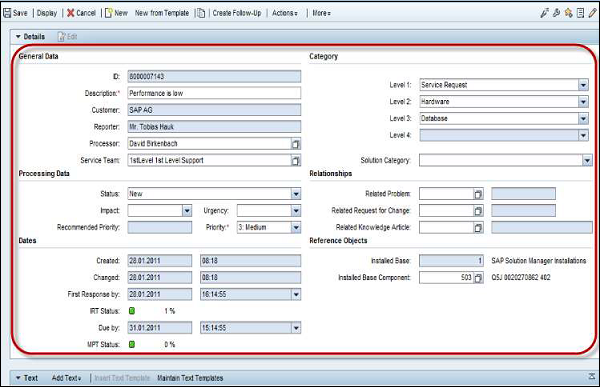
Example
Let us say you want to create a new Sales Order and an Order type is missing.
Step 1 − Go to Help → Create Support Message
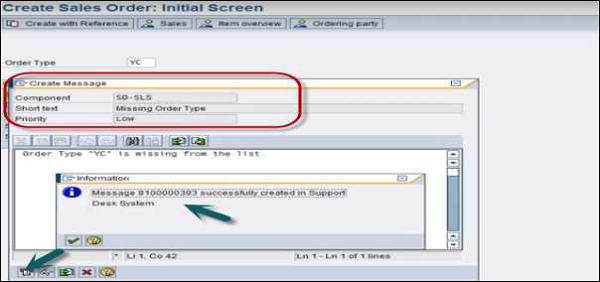
Step 2 − Enter short text and message description and click the Submit button. You will get a prompt- message XXXXX successfully created in support Desk system.
Step 3 − To create an Incident, go to the Transaction Monitor under Service Desk in Solman.
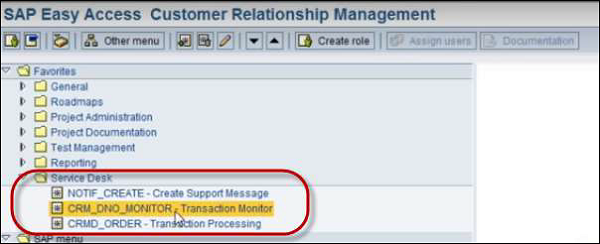
Step 4 − In Transaction Monitor, select Transaction Type- ZSMD Service Desk Message Type, and click Execute.
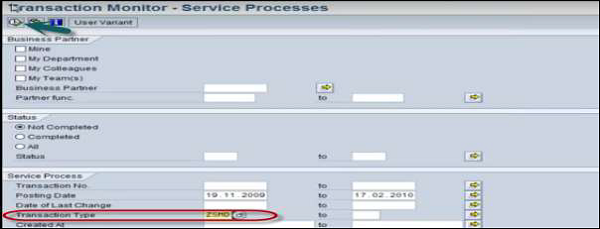
Step 5 − You will see the Support Message created in the list as shown below. Open the Support message.
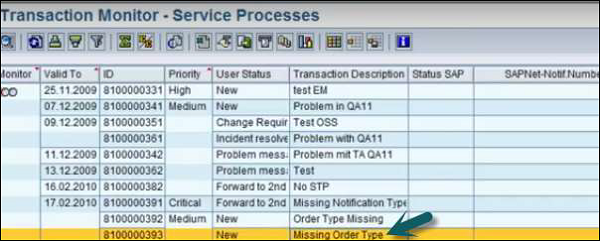
Step 6 − Click the Edit button and change the status to In Process. Once you make the changes, click the save button at the top.
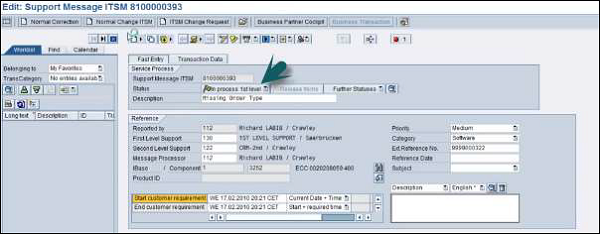
Step 7 − First level support team can see if the issue has occurred before. They can check solution database to find any similar issues.

Step 8 − In case there is no solution that matches the description, Service Desk support forwards the incident to the 2nd level support.
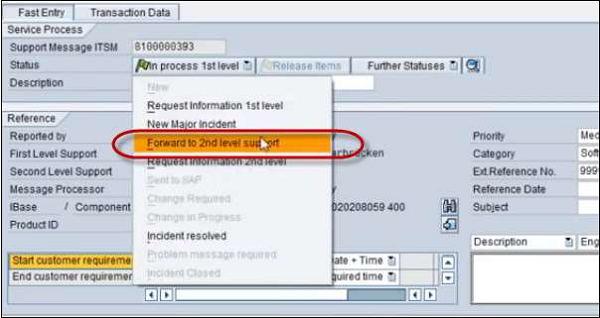
Step 9 − The 2nd Level support team can check the Solution directory to find any past records matching this incident description. If the solution is not available, they can also check SAP Market Place. If no solution is provided, Incident can be forwarded to SAP Global support team.
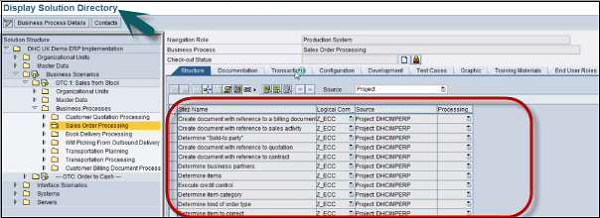
Step 10 − To send the message to SAP Active Global support, click Actions → Send Message to SAP.
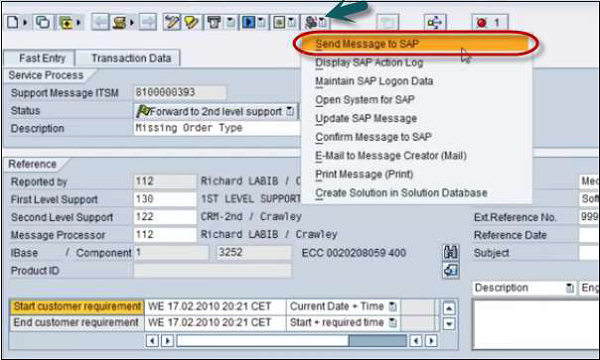
Once the issue is fixed, you can move to Incident Closure with documentation of all the steps that have been performed to fix the issues.
SAP Solman - Business Process Operations
In this Work Center, you can perform the functions that support your core business processes. In SAP Solution Manager, you have two types of Business Process Monitoring work centers. Both the work centers allow you to access all the key functions related to business processes. Business Process Monitoring Work Center also provides monitoring of relevant functions and reporting.
You can see the following two tabs −
- Business Process Operations (new) Work Center
- Business Process Operations Work Center
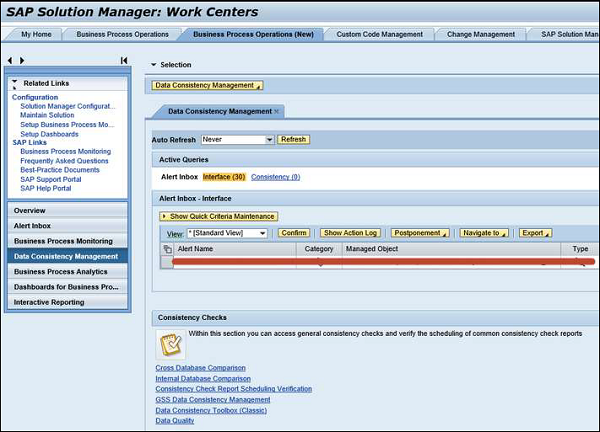
In the left pane, you will see the following functions −
Overview − Using the Overview tab, you can access all other work areas in this Work Center.
Alert Inbox − In Alert Inbox, you can check all the critical alerts for which there are open alert groups for your monitored business processes.
Business Process Monitoring − Under Business Process Monitoring, you can access all metrics as per Monitoring and Alerting Infrastructure.
Data Consistency Management − You can use this to get a filtered view of the Alert inbox for all relevant open alert groups in BPM.
Business Process Analytics − This work area allows you to access key figures such as comparing OU’s, business document backlogs, etc.
Dashboard for Business Processes − The data from business processes can be displayed in the form of Dashboards like Graphics.
Interactive Reporting − This work area is used to display the metrics in Business Process Monitoring.
SAP Solman - Application Operations
In SAP Solution Manager, you can use Application Operations work center to perform all activities related to central monitoring, alerting, and to analyze the solutions. You can use the reporting function to run the reports and also to monitor the status of complex landscapes.
You can perform data volume analysis in your system landscape and you can reduce the total cost by decreasing the size of database.
Using Root Cause Analysis and Exception Management, you can find the root cause of an incident and implement a solution for distributed environment.
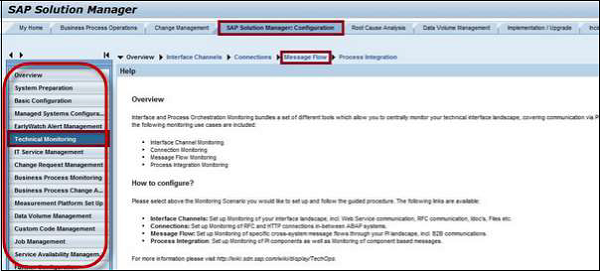
You have the following work areas under Application Operations Work Center −
Technical Monitoring Work Center
The Technical Monitoring work center can be configured using Transaction: SOLMAN_SETUP
Using System Monitoring, you can monitor the status of hosts, systems, and databases in the Solution Manager System landscape.
The Technical monitoring also involves Integration Monitoring, where you can perform −
- PI Monitoring
- Interface and Connection Monitoring
- Message Flow Monitoring
- Connection Monitoring
- Workflow Monitoring
Other Work Centers that come under Application Operations are −
Technical Administration Work Center
Root Cause Analysis Work Center
Data Volume Management Work Center: You can perform data volume analysis in your system landscape and you can reduce the total cost by decreasing the size of database.
The following screenshot shows the SAP Solution Manager Configuration −
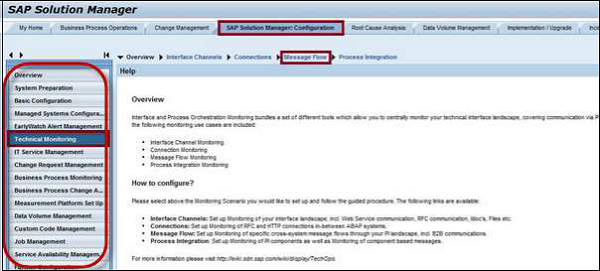
SAP Solman - Maintenance Management
Maintenance Management includes importing enhancement and support packages, and implementing critical SAP Notes. This function allows you to perform multiple functions for system Landscape.
The following work areas come under Maintenance Management −
System Recommendations − You can use this work area to implement Security notes, Performance notes and correction notes for technical systems. This work area comes under Change Management Work Center.
Maintenance Planner − You can use Maintenance Planner to create maintenance plans and stack XML files for installation using Software Update Manager SUM. IT replaces Maintenance Optimizer in Solution Manager to perform updates, and upgrades installation.
Maintenance Optimizer − Maintenance optimizer can be used to start maintenance process in production system. This provides you detailed instruction for downloading and installing maintenance files in the system.
License Management − To download SAP Support Packages, you need license and maintenance certificates. This function is available under Change Management Work Center.
Scope and Effort Analyzer − This work area is used to analyze and calculate the scope and effort required to implement support and Enhance packages on Technical systems. This work area can be started from the following Work Centers −
Change Management Work Center
Test Management Work Center
Custom Code Management Work Center
The following screenshot shows the work centers of Maintenance Management.
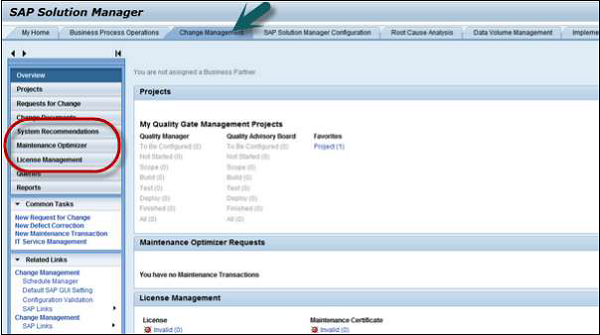
To use this function, you need the following roles −
SAP_SEA_ALL_COMP − Full Authorization of scope and effort analyzer composite Role
SAP_SEA_DIS_COMP − Display Authorization of scope and effort analyzer composite Role
SAP Solman - Upgrade Project
To manage Upgrade management, SAP Solution Manager provides you with an access to all functions required to perform an upgrade. Using SAP Upgrade Roadmap in Solman, you can perform standard methodology to plan and execute an SAP upgrade project. Various predefined templates are provided in Solution Manager to effectively manage the upgrade project end-to-end. It allows SAP customers to better understand and manage the major technical risks and challenges within an upgrade project.
To perform Upgrade management, you need to implement a new upgrade project under Project Administration. Following are the key phases in an Upgrade project −
Creating an Upgrade Project
To define a new upgrade project, you have to go to Project Administration Work Center. You have to select Project type as Upgrade project and define the scope of the project. You can also use an existing project as a base project to copy.
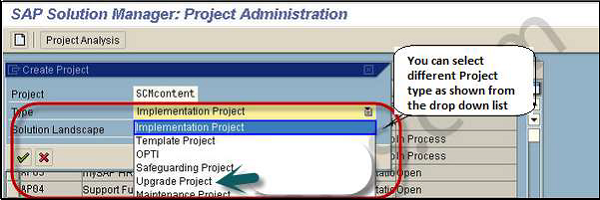
Evaluating System Landscape
Before an upgrade, you need to evaluate current business processes and existing system Landscape. Various applications can be installed on current System Landscape- SAP CRM, SAP SCM, etc. Using dependency analysis of upgrades and use of other tools, you can analyze if your current functions will be available once the upgrade is performed.
Planning Phase
Planning phase includes defining blueprints and Roadmap of the upgrade project. Under Business Blueprint, you enhance the project structure for the business processes. You separate business scenarios and business processes and assign different transactions, functions to the structure items.
Testing
In Testing phase, updated business processes and scenarios are tested.
Transferring Business Processes to Production
In this phase, you transfer the business processes and scenarios to customer specific location like Solution Directory where business processes are monitored under operations.
Reporting
In this phase, you create phase wise reports for full upgrade project.
Implementation/Upgrade Work Center
The following screenshot shows the Implementation/Upgrade Work Center.
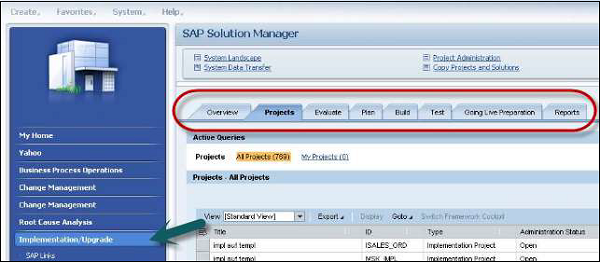
You have the following work areas under this work center −
Overview − The Overview tab shows you the structured diagram of your project status. You can navigate to My Projects, which shows the project to which you are assigned. The All Projects option shows a list of all the authorized projects you can view.
Projects − In the Projects work area, you can see a list of all projects as per the project type, status, etc. When you select any of the project, you can check the header details and blueprint locks in the project.
Evaluate − In this work area, you can access- SAP Standard Scenarios, Business maps, and business functions.
Plan − In this work area, you can create and edit projects, display Roadmaps, and specify Business Blueprints.
Build − In this work area, you can access Technical Configuration, customizing distributions, BC sets, and manage learning materials.
Going Live Preparation − The following links can be accessed in this work area
Solution Directory − To transfer an upgrade project to solution.
SAP GoingLive − This is used to check production start.
SAP EarlyWatch Alert − This is used for production processing and to monitor the solution in SAP Solution Manager. Report can be displayed as an HTML document or a word document.This can be used to identify and avoid key potential problems in the system.
Report − This work area is used to run the reports for project phases and key activities.
SAP Solman - Root Cause Analysis
Root Cause Analysis is used to monitor and analyze the SAP Solman Landscape and to identify the component causing the problem. Using Root Cause diagnostic agent, you can perform an end-to-end diagnostics that provides a structured evaluation method to find the root causes of an undesired outcome and the actions adequate to prevent recurrence.
End-to-End Root Cause Analysis in SAP Solution Manager offers capabilities for cross system and technology root cause analysis. In heterogeneous landscapes especially, it is important to isolate a problem causing component as fast as possible and involve the right experts for problem resolution.
With the tool set provided by Root Cause Analysis, this is possible with the same tool regardless of the technology an application is based on. It allows a first in depth analysis by a generalist avoiding the ping-pong game during an analysis between different expert groups.
The screenshot shows the Root Cause Analysis work center provided.
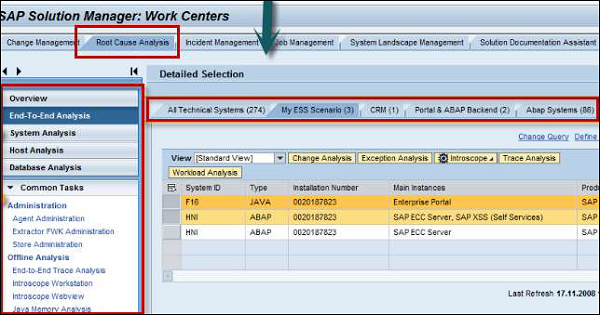
Each tab contains the further work areas to perform the diagnostic for different technical objects −
End-to-End analysis
End-to-End Change Analysis
End-to-End Exception Analysis
End-to-End Trace Analysis
End-to-End Workload Analysis
System Analysis
Change Reporting
Expert Analysis
Log Viewer
Host Analysis
File System Browser
OS Command Console
Database Analysis
Database Monitoring
SAP Solman - Reporting
You can create various interactive reports and Dashboards in SAP Solution Manager.
Interactive Reporting
Interactive reporting allows you to display most important metrics of the objects in System Landscape. The following object types are available −
- Systems
- Hosts
- Databases
- Scenarios
You can use SAP BW system to move these metrics. Reports are created to get a quick view of the Key Performance Indicators. Reports can be created for the following metric values
- Capacity Reports
- Availability Reports
- Performance Reports
- Usage
Application Dashboards
Application Dashboards allow you create Dashboards to ensure that your technical systems and scenarios are available and performing as per the requirement. Application Dashboard can show the following values
- System Availability
- System Performance
- EUE Reporting
Service Level Reporting
Service Level Reporting is used to monitor internal and external service level agreement. This report is based on SAP Early Watch Alert. This report consistently performs check on KPI’s
- System Availability
- Threshold Report
- Periodic reports as per specific time period.
Note − The Service Level Reports can be stored in HTML format or MS Word format.
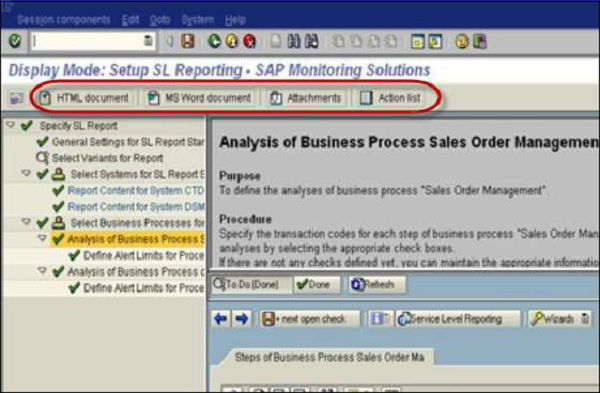
To create a Service Level Report, go to Service Level Report view.
To create HTML report
- Select the link to a Service Level Report.
- In HTML format, you can the report in mail as an attachment to multiple recipients.
To create MS Word document report
To get Service Level Report in doc format, click the Word format symbol and select the report that you want in Doc format. This report comes as an attachment in Report view.
SAP Solman - Consultant Responsibilities
Following are the key job responsibilities of a SAP Solution Manager Consultant −
Person should have an experience in Configuring and Supporting Solution Manager 7.0 and 7.1.
Experience in setting up and troubleshooting BPM.
Should be able to present and interact business process owners in the environment.
Must have good working experience on other components of Solman system Admin and Monitoring, Remote Supportability, Solution Manager Work Centers.
Managed SAP Solman Implementation from top to bottom starting with change management and project planning, to physical transports of changes from the development environment into the productive environment.
Performance Optimization of Systems connected to Solman System.
Managing SAP Operations, System Landscape Information, IT Task Management and GPA, Template Management, Test Management activities.
Excellent documentation skills for configuration, troubleshooting and ongoing maintenance of the environment.